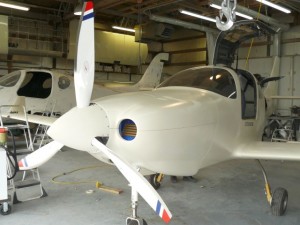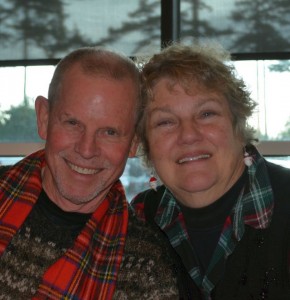My wife Anne and I were aboard our IVP for its maiden cross country flight on the way to the 2013 LOBO/Lancair Landing in Greenville, SC this past October. The first leg from Port Townsend, WA on the Olympic Peninsula was fantastic. Pressurization is only half effective so I filed for 17,000 giving a reasonably comfortable cabin altitude of about 9,500 feet. I have been running the engine very conservatively and was burning about 15.5 gph at 28” MAP. We went through some broken cloud layers over the approach to the Cascades, but were soon above the weather and the ride was smooth. At about 3 hours 45 minutes we were approaching our filed destination of Valentine, NE. With plenty of gas left we elected to extend to Norfolk (pronounced Norfork in NE), landing at 4 hours 20 minutes of flight time with roughly 25 gallons fuel remaining. We were treated like royalty at the FBO, with courteous help from the line staff at the self-serve pump, free tie down and a courtesy car complete with directions to a very nice motel for our overnight stay. Fuel was $5.11 so we felt like we’d hit the jackpot.
Trouble in Paradise
The next morning we got up late and made our way to the airport. Having overflown the biggest rocks, we opted to continue east VFR at 15,500. Engine run-up, takeoff and climb out were all routine. At level off for cruise my brain short circuited, and I forgot to reset the prop and lean, although I did remember to pull the power back to about 28”. Twenty minutes or so later I realized I was running full rich and proceeded to set up for LOP. The second I pulled the mixture back, however, turbine inlet temperatures (TITs) went through the roof with exhaust gas temperatures (EGTs) following. The engine monitor’s voice warning was complementing a whole lot of red annunciators on the Chelton screen, so I immediately went back to full rich.
I was wide awake for sure now!
Temps went back down, but remained more in the yellow than the green. I set fairly conservative caution levels on temps, so I was attempting to keep EGTs below 1500 and TITs below 1550. Throttling back to 24” MAP at 21 gph met those goals, but required the mixture set to full rich; the only way to adjust for the occasional venture into the yellow arcs was to adjust the throttle. Two additional attempts to lean beyond peak yielded the same alarming results and were promptly abandoned. Back to full rich. My calculations determined we had enough petrol at those settings to make our destination with about 15 gal to spare.
Data Detective
 John's IVP in the barn.
John's IVP in the barn.
After landing at Greenville, securing the aircraft and cleaning out my shorts, I downloaded the flight log. We had a pleasant time visiting with other arriving attendees while we sorted out rental car and so forth. The next day I asked for and got assistance analyzing the problem from several folks with ideas and advice using the Savvy Analysis tools on Mike Busch’s website. As the mystery deepened many people offered their help including the representative from Continental Motors, several experienced Lancair drivers as well as Allen Barrett, who had overhauled the engine about 30 hours prior and chimed in via cell phone. The consensus was a problem with either the waste gate controller or the engine driven fuel pump, or perhaps a batch of bad gas.
The following morning Ron Galbraith went with me to the airport and we decided to take the easy route first by replacing the gas in one wing. The plan was to fly the aircraft burning fuel from that wing and see if the problem persisted. Engine start was normal and we taxied to the run-up area. During the run-up we discovered the engine quit firing when switching to the Lightspeed Plasma III ignition. Problem found. The engine ran OK on the mag but the LS was dead.
The next few days were spent attending LOBO functions with troubleshooting sessions at the airport whenever we had a spare minute. Many of our fellow Lancair owners were helpful beyond belief, donating the use of their tools, meters, parts, materials and time. Klaus Savier was very helpful calling me back on the weekend and agreeing to send a loaner box overnight when we determined I didn't have the equipment or tools to properly check out the circuitry.
Repairman
The replacement box arrived Tuesday morning after the LOBO folks had left. I installed it and started up the engine with no improvement. Bummer! I wondered if the ignition switch in the Vertical Power panel could be the culprit, so turned my attention to troubleshooting that item. Finally I had the good sense to call Jason Smith at Aerotronics, who talked me through tests which led to a bad ground to the LS ignition. The circuit was not open but had developed high resistance. Some might say this is a negative comment on Lightspeed, but I will point out that the problem didn't have anything to do with the system itself but rather with the quality of the ground that was wired in by the installer – probably me. Armed with knowledge, I spliced in a parallel ground and tested it with a proper engine run-up. Problem solved.
We departed the following morning and experienced no further symptoms. We dodged a lot of weather on the way home and had to scrap portions of our planned itinerary, including a trip to the DC area to visit old friends.
Lessons Learned
There were some important lessons learned from this experience and I’ll share a couple. First is the advice to check the magnetos after landing. This would have identified the problem about three days earlier. Another is to perform ignition checks while flying; you will find out more about magneto performance than you will in a ground test. Aside from offering data analysis, Mike Busch discusses magneto and ignition system testing and diagnostics on his website and in articles written for online publishers. A couple of good ones can be found here and here.
Another lesson to consider is that it might have been wisest to land at the nearest suitable airport when the problem first occurred and find the fix there. I considered that during the flight but since the engine was running and I was able to control the temperatures I decided I would be better served by continuing to Greenville and taking advantage of the combined wisdom I would find there. Whatever decision one might make, I certainly would not criticize anyone for taking the cautious approach.
The explanation of the engine behavior has been discussed fairly thoroughly on the LML and those who have not seen it would be well advised to review the comments there. The bottom line is that I have lots of folks to thank for selfless assistance – some are LOBO members, some are employees of or business owners at the Greenville downtown airport and some are just helpful pilots who happened to be at the airport and offered to assist.
As many have stated, LOBO is a great organization and I’m proud to be part of it. My first LOBO/Lancair Landing exceeded my expectations, and in spite of the distracting engine problems I learned a great deal about my aircraft and how to minimize risks while maximizing utility.

